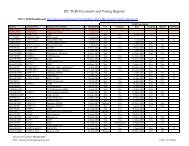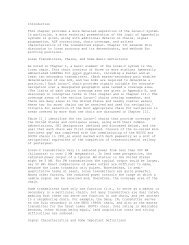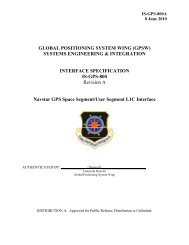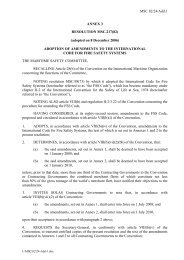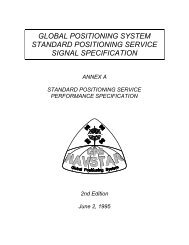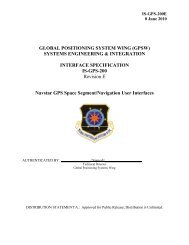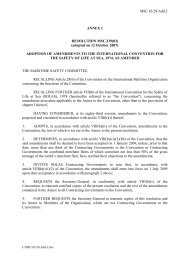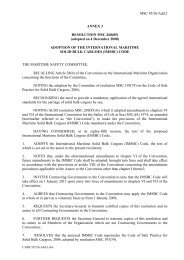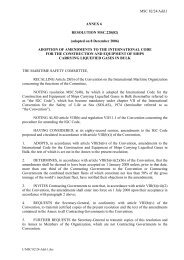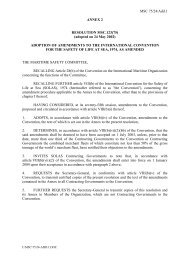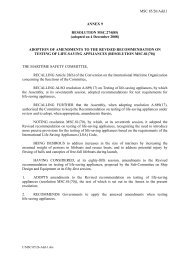TFSR-63 - US Coast Guard Navigation Center
TFSR-63 - US Coast Guard Navigation Center
TFSR-63 - US Coast Guard Navigation Center
You also want an ePaper? Increase the reach of your titles
YUMPU automatically turns print PDFs into web optimized ePapers that Google loves.
NATIONAL GMDSS IMPLEMENTATION TASK FORCENewsletter and Summary Record of 20 May 2010 MeetingThe Summary Record. This summary record is provided for information andwill be posted on the Task Force portion of the <strong>Coast</strong> <strong>Guard</strong> web site atwww.navcen.uscg.gov/marcomms/ (click GMDSS, then GMDSS Task Force). Thesummary record is also distributed to all Task Force members to serve as a Newslettersummarizing GMDSS developments and other issues in marine telecommunications. TheGMDSS Task Force met on 20 May 2010 in San Diego, California during the RTCMAnnual Assembly. The documents listed below were distributed and are available onrequest:Boat<strong>US</strong> Foundation News Release on Rental EPIRBs with GPS Locating<strong>Coast</strong> <strong>Guard</strong> Safety Alert on VHF-DSC Radio Automatic Channel Switching<strong>Coast</strong> <strong>Guard</strong> Policy Letter re Inspection of Uninspected Towing VesselsUK MAIB on Failure of SOLAS Vessels to Respond to MAYDAY RELAYS<strong>Coast</strong> <strong>Guard</strong> Safety Alert on AIS Text Messaging for <strong>Navigation</strong> & Emergencies<strong>Coast</strong> <strong>Guard</strong> News Release on Fog Horn Activation by VHF Radio1. Summary Record of 7 January 2010 Meeting: The Summary Record of the 7January 2010 meeting which had been distributed earlier was noted without change.2. The <strong>Coast</strong> <strong>Guard</strong> Reports:a. Search and Rescue Issues Needing Task Force Support. Captain DaveMcBride reported for the Office of Search and Rescue on new trends in the use of radiotechnology in SAR cases. An example is the RTCM work to set minimum standards fordevices such as SPOT which advertise emergency alerting services. There was discussionof the pros and cons in the use of AIS Text Messaging for Distress Alerts (see thefollowing sub paragraph) and whether it would be useful to publish the email addressesof RCCs for the convenience of the public.b. New Regulatory Initiatives in AIS and ECDIS. Jorge Arroyo reported for theOffice of Waterways Management that the U.S. has tracked 35,000 to 40,000 unique AISvessels to date; just under 7000 per day. There were no new developments in thecontinuing rulemaking process regarding carriage of Automatic Identification Systems(AIS) and Electronic Chart Display Systems (ECDIS) to report at this time.Jorge mentioned a forthcoming <strong>Coast</strong> <strong>Guard</strong> Safety Alert entitled “AIS TextMessaging Concerns: Usage During <strong>Navigation</strong> and Emergencies and Ensuring AccurateData”. This alert was released 27 May and reminds operators that use of AIS textmessaging does not relieve them of other requirements such as Bridge-to-BridgeRadiotelephone Regulations or the requirements to sound whistle signals and displaylights in accordance with the International or Inland <strong>Navigation</strong> Rules. The Safety Alertcan be viewed at http://navcen.uscg.gov/enav/ais/0510.pdf. With respect to use of AIS
Text Messaging during emergencies, the Safety Alert cautions operators that TextMessages may not be received, recognized, or acted upon by in the same fashion as alertsin the GMDSS system. It is acknowledged, however, that AIS text messaging can be auseful augmentation of GMDSS.On May 25 th , a <strong>Coast</strong> <strong>Guard</strong> San Diego News Release cited the reactivation of theMission Bay Jetty fog signal which had been destroyed in a storm 10 years ago. Thesignificance of this reactivated fog signal is that it is user activated by calling on VHFchannel 79A and pressing the mike button 5 times. This is the second west coastinstallation of this type of boater activated fog signal but the technology has been usedsuccessfully throughout the Great Lakes and represents a more cost effective solutionthan the earlier cell phone activated fog signal which required a dedicated phone line.c. Status Report on Rescue 21 VHF–DSC for Sea Area A1. CDR SteveOsgood provided an update for the Rescue 21 Program. The following are highlights:1.) One of the best features of the new Rescue 21 upgrade is the highlyaccurate direction finding capability which is proving to be a big assist in locatingdistress calls from vessels without DSC and from DSC capable vessels without aconnected navigation receiver. The D/F has also enabled prompt resolution of severalhoax calls.2.) The east coast is largely completed except for some gaps in the NorthCarolina and Corpus Christi Sectors which need to be filled.3.). The west coast is also filling in nicely with Sector San Diego declaredoperational last month. There are gaps to be filled in on San Clemente Island and the BigSur area south of Carmel. Sector San Francisco is still outstanding as are someorganizational changes in the 13 th District.4.) One of the first rescues involving DSC occurred recently and wasquickly resolved with a helicopter dispatched to the scene.d. Status of MF-DSC <strong>Coast</strong>al Network Upgrade to DSC for Sea Area A2.Dave Fowler provided an in depth review of his study of the <strong>Coast</strong> <strong>Guard</strong>’s reception ofsafety and distress calls on 2 MHz frequencies as determined from the <strong>Coast</strong> <strong>Guard</strong>database of SAR cases. Surprisingly, the study revealed more use of MF for safetycommunications than had been expected, especially from fishing vessels. There may belimited funding available to ‘shore up’ a few weak spots but the longer term upgradeswill likely be further constrained by new budget realities. Some statistics from his report:1.) The study looked at reception by MF/HF Voice and DSC as well assatellite (Inmarsat and other), VHF, EPIRB, and phone. The large number of phonenotifications may be partially due to the RCC controller recording manner in which hewas notified and not necessarily the radio system the distressed vessel used.
2.) Initial Notifications during the period 2003-2009 totaled 82K byphone; 61K by VHF; 19K by EPIRB; 2209 by MF/HF; and 1710 by Satellite (afterdiscarding cases from outside U.S. SAR area and cases without lives saved or assisted).3.) Fishing Vessels were the predominate type of vessel which accountsfor relatively few of the MF/HF cases using DSC as F/V have not yet been required toupgrade to DSC.e. Working Group Preparations for COMSAR 14. Russ Levin reported on theresults of Comsar 14 which met in London on 8 March 2010 with the followinghighlights:1). The authorized “scoping exercise” for GMDSS Modernizationreceived relatively little attention as it was assigned to a heavily committed workinggroup. The final decision was to refer the issue to a 2 day meeting of IMO and ITUexperts scheduled for September 2010 in London.2). There was discussion of the problem of retaining the priority forInmarsat safety and distress messages in the shore to ship direction. TheIntergovernmental Maritime Satellite Organization (IMSO) was requested to look intothe issue and report to Comsar 15.3). The Conference again declined to endorse replacement of the EPIRB121.5 MHz homer with an AIS transmitter as few of the less developed countries hadaircraft capable of homing on AIS. Future plans are to reopen the proposal as an optionalalternative similar to the current alternative for Radar SARTs or AIS SARTs.4) Comsar 14 approved a new SafetyNET Manual.f. <strong>Coast</strong> <strong>Guard</strong> Safety Alert on VHF-DSC Automatic Channel Switching. JoeHersey explained that an incident off New York prompted issuance of the Safety Alert toremind operators that on receipt of a VHF-DSC distress alert, distress acknowledgement,or other DSC call where a VHF channel number has been designated, the DSC radioautomatically switches to channel 16 or the other designated channel. This could result ina vessel operator thinking he was still on the Bridge-to-bridge channel 13 making passingarrangements when the radio had shifted off of channel 13. To prevent this fromhappening, the <strong>Coast</strong> <strong>Guard</strong> strongly recommends disabling the automatic channelswitching feature when actively engaged in bridge-to-bridge or Vessel Traffic Service(VTS) communications.g. GMDSS Modernization. RADM Gilbert (Ret.) noted the presentationsrelating to modernization of the GMDSS during various sessions of the RTCM Assemblyearlier in the week and invited interested parties to attend the GMDSS ModernizationWorkshop to be held that afternoon. The output from the Workshop will be sent to allTask Force members as a separate distribution soliciting input and comment on theconclusions reached. The resulting consensus will be recommended to governmental
authorities as input for appropriate international conferences.3. The FCC Reports: Ghassan Khalek reported for the FCC, the following arehighlights of his report:a. Further Part 80 Rule Making. New FCC Rulemaking is expected to bereleased soon dealing with such matters as the phase out of Inmarsat B and E, the <strong>Coast</strong><strong>Guard</strong> Petition on several aspects of the Automatic Identification System (AIS), andseveral adjustments to reflect actions taken by the ITU. Hopefully, the following pendingPetitions will also be resolved:b. Task Force Petition to Authorize Use of Marine Handheld Radios ashorein Maritime Areas. In June 2009, the FCC published the Task Force Petition requestingauthority to use VHF handheld radios ashore in maritime areas allowing 30 days forcomment. The public comment period has ended with no responses either pro or con.c. RTCM Petition to Authorize Small Message Data Services on VHFFrequencies. The RTCM has petitioned the FCC to accept its recommendations for asmall message service on VHF frequencies using data techniques. The Petition waspublished by the FCC and Public Comment closed 15 October 2009. There were 28comments, all favorable.d. Task Force Petition Urging Improved MMSI Management. The FCCdenied the Task Force petition earlier but now hopes to implement many of the TaskForce recommendations when the Universal Licensing System (ULS) is updated in thenear future.e. Ship Station License Update. The following is a tabulation of active ShipStation Licenses:54,920 SA Voluntary Vessels; 29,908 of these also hold MMSI20,533 SB Compulsory Vessels, 13,977 of these also hold MMSI4. Update Report by Satellite Service Provider Inmarsat. Chris Worthamprovided an Inmarsat update with the following highlights:a. Emergency Calling ‘505’ Implemented for the FleetBroadband Service.This emergency calling system has been implemented for use by all FleetBroadband (FB)terminals. The resemblance of ‘505’ to ‘SOS’ is intentional. Alerts via the ‘505’ systemare routed to appropriate RCCs in each satellite ocean region and are free calls. Note that‘505’ does not provide priority for Distress and Safety messages. Inmarsat will seekapproval to qualify for GMDSS certification of the FB 500 (but probably not the FB 150and FB 250) by 2014.b. Marine Safety Information (MSI) Via Fleet Broadband. Fleet Broadbandwill make all SafetyNET MSI available for ships which want to “pull” the information
ather than copying the broadcast. There will be no change to ships for pulling the MSIinformation.c. General Inmarsat Statistics. Inmarsat operates 11 satellites and has over500,000 terminals in service. Maritime accounts for about 55% of the revenue. Take upof the FleetBroadband service has been rapid with over 5,000 terminals already inservice.d. Inmarsat plans to introduce a new global handheld satellite phone called‘IsatPhone Pro’ later this year. There is no likelihood that the handheld will be certifiedfor GMDSS.e. Termination of Inmarsat B Service. Inmarsat plans to terminate Inmarsat Bservice on 31 December 2014 in view of declining use of the service by ships.5. Update Report by Satellite Service Provider Thuraya. Fatima Sajwaniprovided an update on the Thuraya Regional Satellite System with the followinghighlights:a. General Thuraya Statistics. Thuraya is a regional satellite service covering abroad expanse of the Pacific and Indian Oceans and the continents of Europe, Africa, andAsia from 2 geostationary satellites at 44 degrees East and 98.5 degrees East longitude.There are over 250,000 subscribers who utilize Voice, Fax, and Data to 9.6 kbps.Terminals can have integral GPS and maritime coverage includes 80% of the world ports.b. Thuraya Plans to Request Certification for GMDSS Service. Thuraya hasannounced plans to apply to IM O to be certified to provide GMDSS Service. They arealready able to provide Long Range Tracking and Identification (LRIT) and ShipSecurity and Alert Service (SSAS) services to ships within their coverage area sinceThuraya meets the specified functional requirements. Their request to IMO for GMDSScertification could come as early as December of this year.c. Thuraya Plans to Extend Coverage to the Atlantic Ocean. Thuraya’s thirdgeneration expansion plans include establishing near global coverage (excluding polarregions) through new satellite deployments which will also provide redundancy using theexisting constellation.6. The RTCM Report: RTCM President Bob Markle reported on the status ofSpecial Committees of interest to the Task Force are as follows:a. RTCM SC 101/110 on Incorporating GPS in VHF Handhelds. Thecombined Special Committee continues to work on recommended specifications for aVHF DSC handheld with integral GPS.b. RTCM SC 110 on Emergency Beacons. The Committee is considering therole of new U.S. GPS satellites which carry the Distress Alerting Satellite System
(DASS), an ERIPB transponder which could be configured to provide anacknowledgement back to the EPIRB that the alert has been received. While thistechnology enhancement could be provided, it is not currently included in the designbecause of lack of a clear requirement. The Galileo <strong>Navigation</strong> Satellite System will alsosupport EPIRB alerting and is reportedly being designed with response acknowledgementcapability. The U.S. needs to make a clear statement of requirement. It appears to theTask Force that the capability would be especially desirable in maintaining morale of thesurvivors pending rescue.c. RTCM SC-121 on Automatic Identification Systems (AIS). A WorkingGroup of this Committee has been working on expanded use of AIS in Port areas. ThePort of Tampa is now broadcasting 3 digital messages on the AIS communicationschannel including the NOAA Physical Oceanographic Real Time System (PORTS)information on currents and water levels. The Corps of Engineers is also experimentingwith the use of the AIS channel to broadcast similar information in the vicinity of locks.d. RTCM SC-123 on Data over VHF Channels. As reported earlier, RTCM haspetitioned the FCC to adopt RTCM Standard 12301.1 for transmitting data on VHFchannels. The comment period closed with all comments favorable to the proposal. Earlyapproval action by the FCC is expected.e. RTCM SC-127 on Enhanced Loran. This Committee continues to meet andwork on specifications for a combined Loran/GPS receiver despite the recent terminationof Loran service in the U.S.f. RTCM SC-128 on Satellite Emergency Notification Devices. ThisCommittee was chartered at the request of the <strong>Coast</strong> <strong>Guard</strong> to develop performancestandards for new systems such as SPOT which are being advertised for emergency orlife saving applications with the goal of enhancing reliability and consumer protection. Aworking group of the National Search and Rescue Committee is working with the RTCMSpecial Committee. Note that BOAT<strong>US</strong> is now offering SPOT service to its members.g. Other RTCM Announcements of Interest. The 2011 RTCM Assemblyincluding a Task Force meeting will be held at the Tradewinds Hotel in St. Pete Beach,Florida May 15-20, 2011.7. Reports and Issues: the GMDSS Service Agents & Manufacturers Group.Ralph Sponar’s Group is following several initiatives through an ad hoc group workingwith NMEA representatives as follows:a. Better Definition of “Qualified” Technical Support. The FCC Rules relatingto Class B AIS call for installation by a qualified technician and NMEA has formed an adhoc group to better define ‘qualified’. Recent progress indicates that the NMEA’s CMETcertification will likely be accepted by the FCC as qualifying for the AIS installation andperhaps other requirements such as conducting GMDSS inspections.
. Standard Color Coding for GPS/Radio hookups. The NMEA ad hoc grouphas plans to recommend adoption of a standard color coding which will then berecommended to manufacturers of both GPS receivers and the various marine equipmentsto which the receivers should be connected.c. Recommendation that GMDSS Equipment Accept <strong>US</strong>B InterfaceConnections. The NMEA ad hoc group will also examine this proposal but anyrecommended solution will have to be submitted to IMO which manages the functionalrequirements for GMDSS equipment. In the past there has been reluctance on the part ofIMO to permit use of the computers dedicated to GMDSS equipment for any otherpurpose.8. Reports and Issues: The Recreational Vessel Group Report. Jack Fuechselreported for Chairman Chuck Husick who was unable to attend. The following arehighlights:a. New Marine VHF Handbook from Mercator Publishing. A copy of the newHandbook was circulated to the group. The author, Laszlo Mercz has extensive ITUexperience. The handbook comes with a disc enabling the user to set up a Marine VHFRadio Simulator on a computer. The cover shows a U.S. price of $33.95.b. Promoting MMSI Registrations and GPS Connections. The Task Forcecontinues to pursue a public awareness campaign seeking ways to encourage MMSIregistrations, GPS connections to the DSC radio, and advocating that boats going a mileor more offshore be equipped with VHF radios or EPIRB/PLB.c. Sea Tow Proposal for an Automated Radio Check Service. Charlie Zaloomagain outlined a proposal that Sea Tow is considering for automated radio checks. Ifimplemented, there would be a designated channel in each port area which a boater couldcall requesting a radio check. His transmission would then be played back to him on thesame channel so that he could also evaluate his transmission for clarity etc. Charliedemonstrated the system at the meeting using two handheld low power units.d. San Diego Auxiliarists Exhibit VHF-DSC Demonstrator. Again in 2010local members of the <strong>Coast</strong> <strong>Guard</strong> Auxiliary, Jim Davis and Joe Stevens, exhibited theirportable VHF-DSC demonstrator which they take to boat shows and other events. Theirassistance in promoting MMSI registration and connection of GPS receivers is greatlyappreciated.9. Reports and Issues: the Commercial Vessel Group. There were several itemsof interest to the Commercial Vessel Group as follows:a. Failure of SOLAS Vessels to Respond to MAYDAY Messages. An April2010 Notice from the UK Chief Inspector of Marine Accidents notes that in investigatingthe death of a seafarer they discovered evidence that some vessels within 10 miles of theincident had failed to respond to MAYDAY messages. In debriefing the ships, several
claimed not to have seen the series of distress flares or not to have heard the VHF Alert.A few even claimed not to understand their legal and moral duty to respond. In suchcircumstances it is the duty of every “master of a ship at sea which is in a position to beable to provide assistance” to at least call the search and rescue service and respond.b. <strong>Coast</strong> <strong>Guard</strong> Policy Letter re Inspection of Uninspected Towing Vessels.<strong>Coast</strong> <strong>Guard</strong> Policy Letter 10-02 of 11 March 2010 was distributed for information.Despite the title, many previously uninspected towing vessels are now subject toinspection and the policy letter provides guidance to marine inspectors and describes a“bridging” program to ease to towing vessel industry into a future inspection regime.10. Reports and Issues: the GMDSS Training Group: No issues were raisedpertaining to the Training Group.11. Other Business and the Next Meeting of the GMDSS Task Force: The nextTask Force meeting will be held on Thursday morning 5 August 2010 at the RTCMHeadquarters in Arlington, Virginia. The follow-on meeting will be held on Wednesdaymorning 29 September 2010 in Seattle, Washington during the NMEA Annual Meeting.GMDSS TASK FORCE CONTINUING WORK LIST20 May 20101. Monitor FCC continuing action to update GMDSS Rules (TF)2. Recommend actions to reduce false alerts in GMDSS systems (TF)3. Monitor <strong>Coast</strong> <strong>Guard</strong> Port State GMDSS inspection program (TF)4. Monitor MSI broadcasting programs for compliance with GMDSS Standards (TF)5. Review GMDSS Internet Web Sites and update Task Force portion of <strong>US</strong>CG site (TF)6. Support SOLAS Working Group planning for IMO COMSAR meetings (TF)7. Advocate Canadian coordination to extend GMDSS services to the Great Lakes (TF)8. Review GMDSS concepts and make modernization recommendations (TF)9. Advocate voluntary carriage of VHF or EPIRB/PLBs by all vessels offshore (TF)10. Advocate overhaul of FCC policy and practice on MMSI assignments (TF)11. Monitor non-GMDSS systems: AIS, LRIT, SSAS, VDR, VMS, & E-<strong>Navigation</strong> (TF)12. Recommend updates for <strong>Coast</strong> <strong>Guard</strong> NVIC on GMDSS Requirements (TF)13. Recommend means to facilitate Distress Alerts by Cell Phone & Internet (TF)14. Advocate intership calling on HF GMDSS channels (CV)15. Review Safety Radio and VMS Requirements for Small Fishing Vessels (CV)16. Recommend training programs for non-mandatory users of GMDSS systems (RV)17. Encourage GMDSS handbooks and Internet and video training aids (RV)18. Encourage voluntary users of VHF-DSC Register for MMSI and connect GPS (RV)19. Advocate FCC let R/Vs keep existing MMSI when applying for Station Lic. (RV)20. Encourage Mfgrs. to upgrade GMDSS explanations in equipment manuals (SA)21. Monitor guidelines for GMDSS equipment maintenance & maintainer standards (SA)22. Recommend proper interconnection of GPS receivers with DSC Radios (SA)23. Advocate better FCC & <strong>US</strong>CG management of annual GMDSS inspections (SA)24. Maintain GMDSS Question Pools for FCC and <strong>Coast</strong> <strong>Guard</strong> Examinations (TR)
Key to cognizant groups:(TF) Task Force(CV) Commercial Vessel Task Group(RV) Recreational Vessel Task Group(SA) Service Agents and Manufacturers Task Group(TR) Training Task GroupAttachment: Draft Agenda for Task Force Meeting 5 August 2010 at the RTCMHeadquarters in Arlington, VirginiaPlease refer questions and proposals to Captain Jack Fuechsel at 703-527-0484 orgmdss@comcast.net. If you have an Internet server with spam filters, pleaseauthorize receipt of messages from gmdss@comcast.net(File: <strong>TFSR</strong>-<strong>63</strong>.doc)




